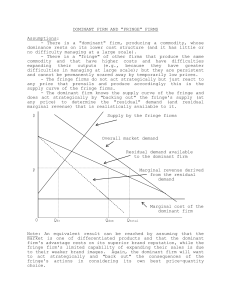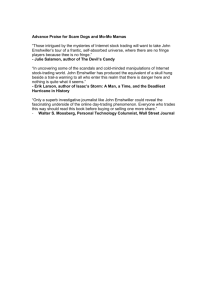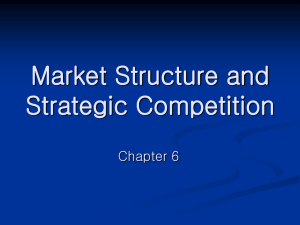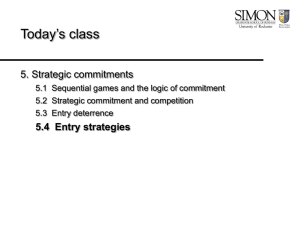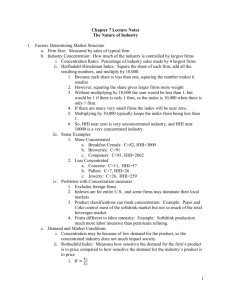Version A - Drake University
advertisement
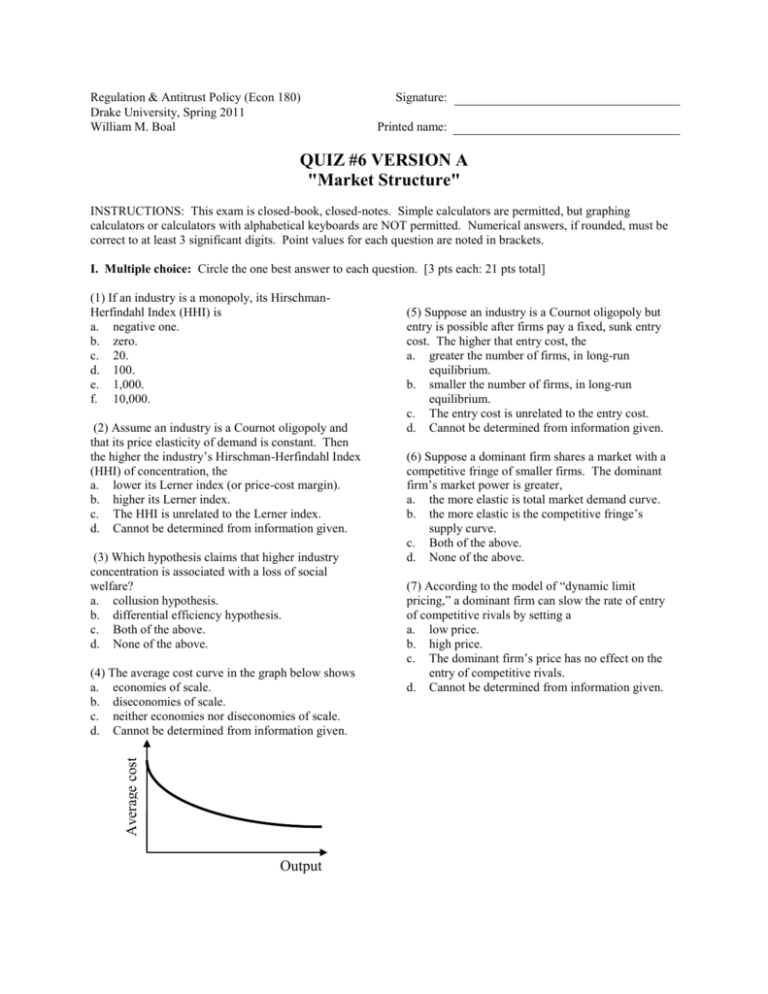
Regulation & Antitrust Policy (Econ 180) Drake University, Spring 2011 William M. Boal Signature: Printed name: QUIZ #6 VERSION A "Market Structure" INSTRUCTIONS: This exam is closed-book, closed-notes. Simple calculators are permitted, but graphing calculators or calculators with alphabetical keyboards are NOT permitted. Numerical answers, if rounded, must be correct to at least 3 significant digits. Point values for each question are noted in brackets. I. Multiple choice: Circle the one best answer to each question. [3 pts each: 21 pts total] (1) If an industry is a monopoly, its HirschmanHerfindahl Index (HHI) is a. negative one. b. zero. c. 20. d. 100. e. 1,000. f. 10,000. (2) Assume an industry is a Cournot oligopoly and that its price elasticity of demand is constant. Then the higher the industry’s Hirschman-Herfindahl Index (HHI) of concentration, the a. lower its Lerner index (or price-cost margin). b. higher its Lerner index. c. The HHI is unrelated to the Lerner index. d. Cannot be determined from information given. (3) Which hypothesis claims that higher industry concentration is associated with a loss of social welfare? a. collusion hypothesis. b. differential efficiency hypothesis. c. Both of the above. d. None of the above. Average cost (4) The average cost curve in the graph below shows a. economies of scale. b. diseconomies of scale. c. neither economies nor diseconomies of scale. d. Cannot be determined from information given. Output (5) Suppose an industry is a Cournot oligopoly but entry is possible after firms pay a fixed, sunk entry cost. The higher that entry cost, the a. greater the number of firms, in long-run equilibrium. b. smaller the number of firms, in long-run equilibrium. c. The entry cost is unrelated to the entry cost. d. Cannot be determined from information given. (6) Suppose a dominant firm shares a market with a competitive fringe of smaller firms. The dominant firm’s market power is greater, a. the more elastic is total market demand curve. b. the more elastic is the competitive fringe’s supply curve. c. Both of the above. d. None of the above. (7) According to the model of “dynamic limit pricing,” a dominant firm can slow the rate of entry of competitive rivals by setting a a. low price. b. high price. c. The dominant firm’s price has no effect on the entry of competitive rivals. d. Cannot be determined from information given. Regulation & Antitrust Policy (Econ 180) Drake University, Spring 2011 Quiz #6 Version A Page 2 of 5 II. Problems: Insert your answer to each question below in the box provided. Feel free to use the margins for scratch workonly the answers in the boxes will be graded. Work carefullypartial credit is not normally given for questions in this section. (1) [Measuring industry concentration: 18 pts] Suppose two industries each consist of six firms with the following market shares. Industry A Industry B Firm #1 25% Firm #1 50% Firm #2 25% Firm #2 10% Firm #3 25% Firm #3 10% Firm #4 10% Firm #4 10% Firm #5 10% Firm #5 10% Firm #6 5% Firm #6 10% a. Suppose Industry A is a Cournot oligopoly. Which firm must have lower marginal cost—Firm #1 or Firm #6? b. Compute Industry A’s four-firm concentration ratio (4CR). c. Compute Industry B’s four-firm concentration ratio (4CR). d. Which industry is more concentrated according to the 4CR? e. Compute Industry A’s Hirschman-Herfindahl index of concentration (HHI). f. Compute Industry B’s Hirschman-Herfindahl index of concentration (HHI). g. Which industry is more concentrated according to the HHI? h. Assume Industry A is a Cournot oligopoly and that the industry's elasticity of demand is -3. Compute its average Lerner index (or "price-cost margin"). [Hint: Recall the formula: avg L = HHI / (10,000 ||) .] i. Assume Industry B is also a Cournot oligopoly and that the industry's elasticity of demand is also -3. Compute its average Lerner index. Regulation & Antitrust Policy (Econ 180) Drake University, Spring 2011 Quiz #6 Version A Page 3 of 5 Price, average cost (2) [Entry barriers and contestable markets: 26 pts] The graph below shows a market where the incumbent firm now produces eight million units of output and charges a price of $5. The average cost curve applies to both the incumbent and any other firm that tries to enter this market. $11 $10 $9 $8 $7 $6 $5 $4 $3 $2 $1 $0 Demand Average cost 0 1 2 3 4 5 6 7 8 9 10 11 12 13 14 Quantity (millions) a. What is minimum average cost? $ b. What is the minimum efficient scale? million c. Assume MC=AC and compute the incumbent’s Lerner index (or "price-cost margin"). [Hint: By definition, the Lerner index = (P-MC)/P.] First, suppose a second firm enters the market and produces three million units of output. Assume the Bain-Sylos postulate: the incumbent firm keeps its output level fixed at eight million and lets the market price fall. d. What is the new market price? $ e. What is the entrant’s average cost? $ f. Does the entrant make a profit or a loss? g. How much? $ million Alternatively, suppose a second firm enters the market and offers a price of $4. Do not assume the Bain-Sylos postulate. Instead assume the market is contestable and the incumbent firm keeps its price fixed at $5. h. What is the entrant’s quantity? million i. What is the entrant’s average cost? $ j. Does the entrant make a profit or a loss? k. How much? $ l. What price should the incumbent set to prevent entry? $ m. Compute the incumbent’s Lerner index (or "price-cost margin") assuming it sets price as in part (l). million Regulation & Antitrust Policy (Econ 180) Drake University, Spring 2011 Quiz #6 Version A Page 4 of 5 Price (3) [Dominant-firm price leadership: 30 pts] Big Corporation is the dominant firm in its industry. The following diagram shows total market demand, the supply curve of the follower firms or "competitive fringe," and the marginal cost for Big Corporation. Assume the "competitive fringe" firms take price as given. $16 $15 $14 $13 $12 $11 $10 $9 $8 $7 $6 $5 $4 $3 $2 $1 $0 Market demand Supply of competitive fringe Marginal cost of dominant firm 0 1 2 3 4 5 6 7 8 9 10 11 12 13 14 15 16 Quantity (millions) a. What is the highest price at which the competitive fringe would supply zero output? $ b. At what price would the quantity supplied by the competitive fringe be sufficient to supply the entire quantity demanded by the market? $ Suppose the market price were $6 for some unknown reason. c. How much output would the competitive fringe supply? million d. How much output would be left for the dominant firm? million Now suppose the dominant firm sets the market price to maximize profit. e. Draw and label the residual demand curve available to the dominant firm, using a straightedge. f. Draw and label the residual marginal revenue curve available to the dominant firm, using a straightedge. g. What quantity will the dominant firm seek to produce to maximize its profit? h. What price will the dominant firm set in the market? i. What quantity will the competitive fringe firms supply as a result? j. Compute the dominant firm's Lerner index (or "price-cost margin"). [Hint: By definition, the Lerner index = (P-MC)/P.] million $ million Regulation & Antitrust Policy (Econ 180) Drake University, Spring 2011 Quiz #6 Version A Page 5 of 5 III. Challenge question: Write a one-paragraph essay answering the following question. [5 pts] Explain the difference between plant-level economies of scale and firm-level economies of scale. Then answer the following questions. a. Do you believe pizza restaurants enjoy plant-level economies of scale? b. Why or why not? c. Do you believe pizza restaurants enjoy firm-level economies of scale? d. Why or why not? [end of quiz]

